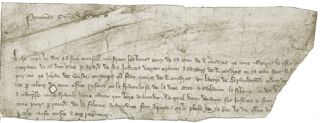Related Research Articles

Bassishaw is a ward in the City of London. Small, it is bounded by wards: Coleman Street, east; Cheap, south; Cripplegate, north; Aldersgate, west.

Sir Wolstan Dixie was an English merchant and administrator, and Lord Mayor of London in 1585.

Coleman Street is one of the 25 ancient wards of the City of London, England, and lies on the City's northern boundary with the London Borough of Islington.

Sir Claudius Stephen Hunter, 1st Baronet, lawyer and Lord Mayor of London.

Sir Geoffrey Boleyn was an English merchant and politician who served as Lord Mayor of London from 1457 to 1458. He purchased the manor of Blickling, near Aylsham, in Norfolk from Sir John Fastolf in 1452, and Hever Castle in Kent in 1462. He was the great-grandfather of Queen Anne Boleyn, the mother of Queen Elizabeth I. Sir Geoffrey built the domestic, mercantile and civic fortunes of the Boleyn family, and raised its status from the provincial gentry, as his brother Thomas Boleyn made a career of distinction in church and university, together building the family's wealth, influence and reputation.
Sir Ralph Warren was twice Lord Mayor of London, for the first time in 1536 and the second in 1543.

Alderman David Henry Stone. His family were the owners of a large amount of land near Lewes for at least three centuries. He was the nephew of Thomas Farncomb the Lord Mayor of London of 1849. Educated at St Olave's Grammar School, in Southwark. He practiced as a solicitor and an attorney from 1839 until 1864.
Sir William Leman, 1st Baronet was an English politician who sat in the House of Commons at various times between 1645 and 1660.

Sir Thomas Bennett or Bennet (1543–1627) was an English merchant and Lord Mayor of London in 1603–04.
Sir William Fitzwilliam was a Merchant Taylor, Sheriff of London, servant of Cardinal Wolsey, and a member of the council of Henry VII.

Abraham Reynardson was an English merchant who was Lord Mayor of London in 1649.
Henry le Walleis was a 13th-century English politician and Mayor of London. His origins are obscure; he was an outsider to London and may have been Welsh by birth. After making his fortune in the wine trade, he became an alderman in 1269 and sheriff in 1270. As alderman, he represented the ward of Cordwainer. He went on to serve five terms as mayor.
Walter Hervey was a 13th-century English Lord Mayor of London. He was elected mayor in the waning days of the reign of Henry III, while the heir apparent was away on a crusade in the Holy Land. At the time of his election, there was an ongoing rivalry between the common citizens of London and the city's aldermen. The aldermen proposed Philip le Tayllor as the new mayor, but a large portion of the citizenry installed Hervey as mayor over their objections. During his term, Hervey signed charters for the various crafts, in effect creating an early form of trade unions. After his term as mayor was ended, Hervey was succeeded by Henry le Walleis. Walleis, along with his political ally Gregory de Rokesley, nullified the charters. Although Hervey attempted to rally his followers to preserve the charters, his efforts were in vain. With royal backing, Henry le Walleis had Hervey formally arraigned on a variety of charges, and ultimately Hervey was hounded out of his office as alderman and forbidden to ever again take part in the governance of the city. After this, there is little record of Walter Hervey, other than that he had a daughter, Anne, who married Thomas Woodchurch.
Sir Robert Chichele was a 15th-century English merchant and Lord Mayor of London.
Nicholas de Farndone was a 14th-century English goldsmith and politician who served four non-consecutive terms as Mayor of London.
Andrew Aubrey was an English merchant and politician, who served three terms as Lord Mayor of London during the reign of Edward III.
Adam Bamme was an English goldsmith and politician who served two non-consecutive terms as Lord Mayor of London in the 14th century.
Sir John Woodcock was an English merchant and politician. He held several offices over the course of his life, including Lord Mayor of London, and exercised considerable influence during the reigns of both Richard II and Henry IV. One of the richest Londoners of his time, he lent large sums to both those rulers.
Hamo de Chigwell was an English merchant and politician. He served seven terms as Lord Mayor of London, between 1319 and 1327. He was a controversial figure, described by a contemporary alderman as "the vilest worm that had been in the City for more than twenty years", and played a role in the struggle for power between King Edward II and Queen Isabella.

John de Gisors was an English Member of Parliament. He was a Member (MP) of the Parliament of England for City of London in 1306 and 1310.
References
- ↑ "Lord Mayors of the City of London from 1189" (PDF). www.citybridgetrust.gov.uk. Archived from the original (PDF) on 14 July 2014. Retrieved 9 June 2014.
- ↑ Fox, Christine M. (2014). "A History of Bassishaw Ward" Ch. 7
- ↑ Williams, Gwyn A. "Medieval London" pg. 323
- ↑ Williams, Gwyn A. "Medieval London" pg. 245
- ↑ Thomas, Henry. "The Wards of London" pg. 55